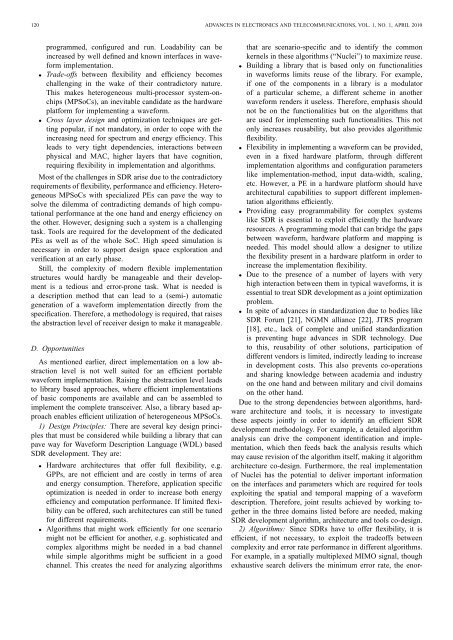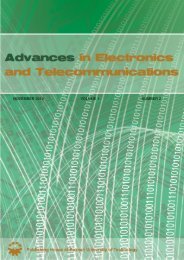channel - Advances in Electronics and Telecommunications
channel - Advances in Electronics and Telecommunications
channel - Advances in Electronics and Telecommunications
You also want an ePaper? Increase the reach of your titles
YUMPU automatically turns print PDFs into web optimized ePapers that Google loves.
120 ADVANCES IN ELECTRONICS AND TELECOMMUNICATIONS, VOL. 1, NO. 1, APRIL 2010<br />
programmed, configured <strong>and</strong> run. Loadability can be<br />
<strong>in</strong>creased by well def<strong>in</strong>ed <strong>and</strong> known <strong>in</strong>terfaces <strong>in</strong> waveform<br />
implementation.<br />
• Trade-offs between flexibility <strong>and</strong> efficiency becomes<br />
challeng<strong>in</strong>g <strong>in</strong> the wake of their contradictory nature.<br />
This makes heterogeneous multi-processor system-onchips<br />
(MPSoCs), an <strong>in</strong>evitable c<strong>and</strong>idate as the hardware<br />
platform for implement<strong>in</strong>g a waveform.<br />
• Cross layer design <strong>and</strong> optimization techniques are gett<strong>in</strong>g<br />
popular, if not m<strong>and</strong>atory, <strong>in</strong> order to cope with the<br />
<strong>in</strong>creas<strong>in</strong>g need for spectrum <strong>and</strong> energy efficiency. This<br />
leads to very tight dependencies, <strong>in</strong>teractions between<br />
physical <strong>and</strong> MAC, higher layers that have cognition,<br />
requir<strong>in</strong>g flexibility <strong>in</strong> implementation <strong>and</strong> algorithms.<br />
Most of the challenges <strong>in</strong> SDR arise due to the contradictory<br />
requirements of flexibility, performance <strong>and</strong> efficiency. Heterogeneous<br />
MPSoCs with specialized PEs can pave the way to<br />
solve the dilemma of contradict<strong>in</strong>g dem<strong>and</strong>s of high computational<br />
performance at the one h<strong>and</strong> <strong>and</strong> energy efficiency on<br />
the other. However, design<strong>in</strong>g such a system is a challeng<strong>in</strong>g<br />
task. Tools are required for the development of the dedicated<br />
PEs as well as of the whole SoC. High speed simulation is<br />
necessary <strong>in</strong> order to support design space exploration <strong>and</strong><br />
verification at an early phase.<br />
Still, the complexity of modern flexible implementation<br />
structures would hardly be manageable <strong>and</strong> their development<br />
is a tedious <strong>and</strong> error-prone task. What is needed is<br />
a description method that can lead to a (semi-) automatic<br />
generation of a waveform implementation directly from the<br />
specification. Therefore, a methodology is required, that raises<br />
the abstraction level of receiver design to make it manageable.<br />
D. Opportunities<br />
As mentioned earlier, direct implementation on a low abstraction<br />
level is not well suited for an efficient portable<br />
waveform implementation. Rais<strong>in</strong>g the abstraction level leads<br />
to library based approaches, where efficient implementations<br />
of basic components are available <strong>and</strong> can be assembled to<br />
implement the complete transceiver. Also, a library based approach<br />
enables efficient utilization of heterogeneous MPSoCs.<br />
1) Design Pr<strong>in</strong>ciples: There are several key design pr<strong>in</strong>ciples<br />
that must be considered while build<strong>in</strong>g a library that can<br />
pave way for Waveform Description Language (WDL) based<br />
SDR development. They are:<br />
• Hardware architectures that offer full flexibility, e.g.<br />
GPPs, are not efficient <strong>and</strong> are costly <strong>in</strong> terms of area<br />
<strong>and</strong> energy consumption. Therefore, application specific<br />
optimization is needed <strong>in</strong> order to <strong>in</strong>crease both energy<br />
efficiency <strong>and</strong> computation performance. If limited flexibility<br />
can be offered, such architectures can still be tuned<br />
for different requirements.<br />
• Algorithms that might work efficiently for one scenario<br />
might not be efficient for another, e.g. sophisticated <strong>and</strong><br />
complex algorithms might be needed <strong>in</strong> a bad <strong>channel</strong><br />
while simple algorithms might be sufficient <strong>in</strong> a good<br />
<strong>channel</strong>. This creates the need for analyz<strong>in</strong>g algorithms<br />
that are scenario-specific <strong>and</strong> to identify the common<br />
kernels <strong>in</strong> these algorithms (“Nuclei”) to maximize reuse.<br />
• Build<strong>in</strong>g a library that is based only on functionalities<br />
<strong>in</strong> waveforms limits reuse of the library. For example,<br />
if one of the components <strong>in</strong> a library is a modulator<br />
of a particular scheme, a different scheme <strong>in</strong> another<br />
waveform renders it useless. Therefore, emphasis should<br />
not be on the functionalities but on the algorithms that<br />
are used for implement<strong>in</strong>g such functionalities. This not<br />
only <strong>in</strong>creases reusability, but also provides algorithmic<br />
flexibility.<br />
• Flexibility <strong>in</strong> implement<strong>in</strong>g a waveform can be provided,<br />
even <strong>in</strong> a fixed hardware platform, through different<br />
implementation algorithms <strong>and</strong> configuration parameters<br />
like implementation-method, <strong>in</strong>put data-width, scal<strong>in</strong>g,<br />
etc. However, a PE <strong>in</strong> a hardware platform should have<br />
architectural capabilities to support different implementation<br />
algorithms efficiently.<br />
• Provid<strong>in</strong>g easy programmability for complex systems<br />
like SDR is essential to exploit efficiently the hardware<br />
resources. A programm<strong>in</strong>g model that can bridge the gaps<br />
between waveform, hardware platform <strong>and</strong> mapp<strong>in</strong>g is<br />
needed. This model should allow a designer to utilize<br />
the flexibility present <strong>in</strong> a hardware platform <strong>in</strong> order to<br />
<strong>in</strong>crease the implementation flexibility.<br />
• Due to the presence of a number of layers with very<br />
high <strong>in</strong>teraction between them <strong>in</strong> typical waveforms, it is<br />
essential to treat SDR development as a jo<strong>in</strong>t optimization<br />
problem.<br />
• In spite of advances <strong>in</strong> st<strong>and</strong>ardization due to bodies like<br />
SDR Forum [21], NGMN alliance [22], JTRS program<br />
[18], etc., lack of complete <strong>and</strong> unified st<strong>and</strong>ardization<br />
is prevent<strong>in</strong>g huge advances <strong>in</strong> SDR technology. Due<br />
to this, reusability of other solutions, participation of<br />
different vendors is limited, <strong>in</strong>directly lead<strong>in</strong>g to <strong>in</strong>crease<br />
<strong>in</strong> development costs. This also prevents co-operations<br />
<strong>and</strong> shar<strong>in</strong>g knowledge between academia <strong>and</strong> <strong>in</strong>dustry<br />
on the one h<strong>and</strong> <strong>and</strong> between military <strong>and</strong> civil doma<strong>in</strong>s<br />
on the other h<strong>and</strong>.<br />
Due to the strong dependencies between algorithms, hardware<br />
architecture <strong>and</strong> tools, it is necessary to <strong>in</strong>vestigate<br />
these aspects jo<strong>in</strong>tly <strong>in</strong> order to identify an efficient SDR<br />
development methodology. For example, a detailed algorithm<br />
analysis can drive the component identification <strong>and</strong> implementation,<br />
which then feeds back the analysis results which<br />
may cause revision of the algorithm itself, mak<strong>in</strong>g it algorithm<br />
architecture co-design. Furthermore, the real implementation<br />
of Nuclei has the potential to deliver important <strong>in</strong>formation<br />
on the <strong>in</strong>terfaces <strong>and</strong> parameters which are required for tools<br />
exploit<strong>in</strong>g the spatial <strong>and</strong> temporal mapp<strong>in</strong>g of a waveform<br />
description. Therefore, jo<strong>in</strong>t results achieved by work<strong>in</strong>g together<br />
<strong>in</strong> the three doma<strong>in</strong>s listed before are needed, mak<strong>in</strong>g<br />
SDR development algorithm, architecture <strong>and</strong> tools co-design.<br />
2) Algorithms: S<strong>in</strong>ce SDRs have to offer flexibility, it is<br />
efficient, if not necessary, to exploit the tradeoffs between<br />
complexity <strong>and</strong> error rate performance <strong>in</strong> different algorithms.<br />
For example, <strong>in</strong> a spatially multiplexed MIMO signal, though<br />
exhaustive search delivers the m<strong>in</strong>imum error rate, the enor-







